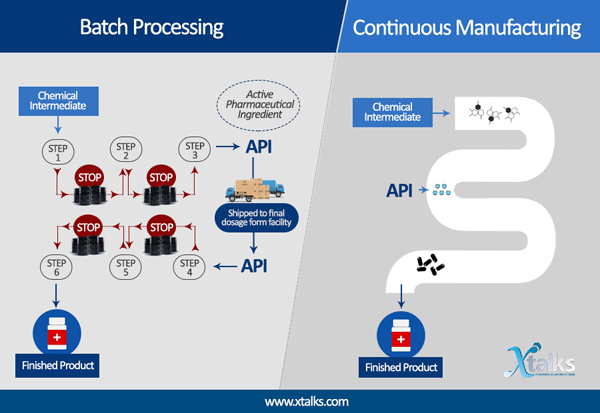Pharmaceutical manufacturing hasn’t changed much in the last 50 years. While it’s true that some advancements have been made in terms of the technology used to create drugs, the underlying processes are still largely the same. Most drugmakers are still relying upon batch processing, in which a pharmaceutical product is made through a step-wise process.
While reliable, batch processing can be a slow way to manufacture drugs. The more time partially-completed products spend between steps, the higher the risk of potential contamination or human error.
Between 2004 and 2015, the total number of drug recalls grew by over 1,200 percent. While it’s true that the number of newly-approved drugs has been growing at a rapid rate every year, this doesn’t fully account for the increase in drug recalls. As many of the issues with contamination occur during the manufacturing process, it’s important that drugmakers implement the best possible production process to limit the risk of recalls and protect consumer safety.
It’s estimated that the pharmaceutical manufacturing industry wastes up to $50 billion per year on inefficient processes. Various raw materials – including the active pharmaceutical ingredient (API) – are produced at separate facilities around the world, adding to the overall inefficiency of batch manufacturing.
Continuous Manufacturing
In contrast to batch processing, continuous manufacturing sends raw materials through an uninterrupted, nonstop process until the final product is completed. This approach is a faster manufacturing method; the US Food and Drug Administration (FDA) estimates that some drugs which normally take a month to produce using conventional batch processing, may only take one day to make using a continuous manufacturing setup.
Continuous manufacturing – which is the standard method in a number of other sectors, including the automotive, food and electronics industries – is currently used to produce primarily over-the-counter, largely non-pharmaceutical products, such as personal care items. While the technology could be applied to pharmaceutical production, the industry has been slow to adopt continuous processing due in part to its high startup costs.
Along with being a faster, more efficient way to manufacture pharmaceuticals, continuous processing could also be safer compared to batch methods. By eliminating steps involving human intervention, the risk of error could be substantially decreased.
Continuous manufacturing methods also allow quality control to be built directly into the process of drug production. In the case of an identified quality issue, specific quantities of a drug produced via a continuous workflow can still be tracked and identified by a unique lot number.
In addition, once the initial investment into continuous manufacturing equipment, processes and training is recouped, the technique could be an overall cheaper way to produce over-the-counter and prescription drugs. Compared to batch processes, drugmakers who implement a continuous manufacturing method could save between 40 and 50 percent in variable costs, according to the National Science and Technology Council.
These reductions in manufacturing costs could be passed along to consumers in the form of more affordable pharmaceuticals. The continuous processing method could also help prevent drug shortages of vital medications by reducing the lead of time of a given product.
Early Adopters
The continuous drug manufacturing method has already been adopted by some key players in the pharmaceutical industry. Since its approval in July 2015, Vertex’s Orkambi – a drug used to treat patients with cystic fibrosis – has been manufactured using a continuous process.
Earlier this year, pharmaceutical giant Eli Lilly announced that they would be investing €35 million in a purpose-built continuous active pharmaceutical ingredient (API) production facility in Ireland, for products in the company’s late-stage pipeline. The FDA also recently approved the first manufacturing switch from batch to continuous processing of an approved drug. As of last month, Belgium-based drugmaker Janssen has been manufacturing their HIV-1, Prezista, using a continuous manufacturing method.
The FDA has officially endorsed continuous manufacturing in an articles posted on their FDA Voice blog. In addition, the agency has released draft guidance to help pharmaceutical manufacturers modernize their processes.
Despite the lack of regulatory hurdles preventing pharmaceutical companies from adopting a continuous process, there is a lack of experience with the manufacturing technique within the industry. The FDA recommends that drugmakers interested in switching from batch to continuous manufacturing methods have frequent discussions with the regulatory body to facilitate planning and eventual implementation.
As the pharmaceutical industry moves toward precision medicine – in which unique formulations will need to be produced more quickly – it’s unlikely that the traditional batch model will continue to be standard for drug manufacturing. By switching to a continuous process, drugmakers will have more control over their products and will be better able to adapt to changes in demand.











Join or login to leave a comment
JOIN LOGIN